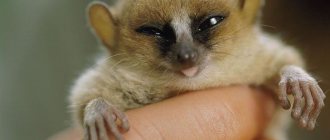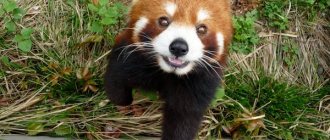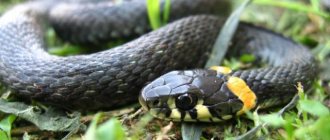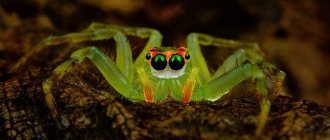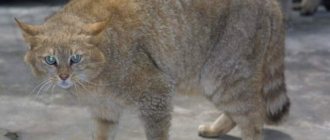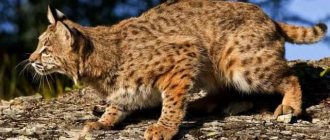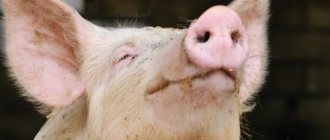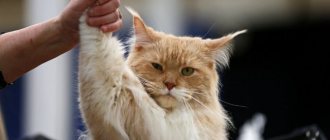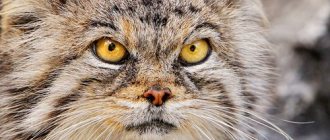Jaguarundi or cat air (international scientific name - Puma yagouaroundi) - belongs to the Subfamily of Small cats (Felinae) and the genus Puma (Puma).
This is one of the rare, unusual and mysterious wild cats that lives only in Central and South America. This cat's chromosome set is much closer to big cats, because she has 38 chromosomes, not 36 like all small cats. The closest relative of the jaguarundi is the puma, which is why this word is present in its scientific name.
Characteristics of appearance
Jaguarundi is a South American representative of big cats, although the size of this animal is quite modest in comparison with its close relatives - pumas. The Jaguarundi is slightly larger in size than a large cat. The height of the cat at the withers reaches 35 cm, length is about 80 cm, tail – 60 cm, weight – up to 10 kg. Externally, cats of this breed look like this:
- The head is small, slightly flattened in shape with a short muzzle.
- The eyes are rounded, their color is tea-brown.
- The ears are rounded at the tip, without any markings on the back side. The absence of spots on the back wall of the ear is considered a unique feature of the jaguarundi, since all representatives of the cat world, both large and small, have such light spots of different sizes.
- The body is elongated, flexible, with a well-developed muscle corset.
- The tail is long and thin, covered with thick and dense hair.
- Wool – thick, short and smooth. The color is uniform, without any color transitions or spots. Small inclusions can only be found in adult jaguarundis. Small spots of color, slightly different in color from the main shade of the coat, may be present on the belly and face of the animal. Color – brown, black, rich red, gray.
Thanks to its well-developed muscles, the cat is endowed with incredible grace and flexibility. The smoothness of her movements is absolutely silent. If we characterize the appearance of a jaguarundi, we can say that by the flexibility and plasticity of the body it is a cat, by its muzzle it is an otter, and by its small, short and powerful legs it is a weasel.
Common names
In addition to the name jaguarundi
, from which the scientific name of the species is derived, it receives other common names in the various regions where it is found, such as
ginger
cat,
Moorish
cat,
brenero
lion
zonto
cat leoncillo
,
unzia
,
candingo
,
tigrillo
,
jaguarundi
,
jaguarundi
.
[1] It is also known as guina
,
gato
lizard gato
otter ,
gato
eira, gato sideboard,
gray cat
and
cat-fox
.
[ link needed
]
Where does the animal live?
In the wild, the South American cat inhabits the territories of the Southern and Central parts of America, and the jaguarundi's favorite habitats are Texas, Mexico, Uruguay and Argentina.
The animal prefers to settle in dry forests and pastures with a lot of wet greenery. Graceful cats are often spotted in the tropics.
Jaguarundis love to climb somewhere higher, living in areas up to 3000 meters above sea level.
Absolutely comfortable living conditions for jaguarundi are lake shores, swampy regions, savannas with sloping meadows of tall cacti.
taxonomy
Nomenclature
In 1803, Étienne Geoffroy Saint-Hilaire described two jaguarundi skins and skulls from unknown locations in Central America and proposed the scientific name Felis yagouarundi
. [ 8 ]
Generic name Herpailurus
was proposed by Nikolai Severtsov in 1858 for the jaguarundi. [ 9 ]
The nomenclature of the Jaguarundi has changed markedly. In the 1970s, this feline was assigned to the genus Herpailurus
subfamily Felinae.
In the late 20th century, the jaguarundi and the puma ( Puma concolor
) were considered monophyletic and placed in the same genus:
Puma
.
[2] In 2022, a group of scientists decided to restore it to the genus Herpailurus
. [3]
Phylogenetic tree
Phylogenetic tree of its origin (as of 2017): [10]
| cougar | |
| Puma jaguarundi - | |
subspecies
There are 8 recognized subspecies of jaguarundi (according to the third edition of Species of the World's Mammals): [2] []
- Hand.
amegina (Holmberg, 1898) - Hey carcomitli
(Berlandier, 1859) - Hey air
(G. Fischer, 1814) - H.u.
pits (Mearns, 1901) - Hand.
melanto (Thomas, 1914) - Hey panamensis
(Allen, 1904) - Hand.
Toltec (Thomas, 1898) - Hey Jaguarundi
(Saint-Hilaire, 1803)
Jaguarundi subspecies
Zoologists distinguish 7 different subspecies of jaguarundi, which were discovered at different times:
- Puma yagouaroundi - lives in the Amazon and Guyana, inhabiting forests.
- Puma yagouaroundi eyra - inhabits Brazil, Argentina and Paraguay.
- Puma yagouaroundi cacomitli - its habitat covers the southern region of Texas and the pampas in Mexico.
- Puma yagouaroundi tolteca - inhabit the North American part of Mexico and Arizona.
- Puma yagouaroundi melantho – Peru and Brazil.
- Puma yagouaroundi ameghini - western Argentina.
- Puma yagouaroundi panamensis – Nicaragua.
These subspecies do not differ in appearance, only their habitats differ.
Scientific classification
- Kingdom: Animalia (animals)
- Phylum: Chordata
- Class: Mammalia (mammals)
- Order: Carnivora (predatory)
- Family: Felidae (felines)
- Genus: Puma (cougars)
- Species: Puma yagouaroundi (jaguarundi)
Another scientific name for the genus "Herpailurus" comes from the Latin word "herpa" ("strange") and the Greek word "ilurus" ("cat"). The specific name "yagouaroundi" comes from the word "yagua", which refers to all carnivorous animals, and the ending "rundi", probably derived from the word "hung'i", meaning "brownish". “Strange brown cat” perfectly describes the jaguarundi.
How they behave and hunt
These beautiful wild cats are loners in life; they gather in pairs or small groups only during the mating period. About 20 km2 is allocated for each individual. Females often live in close proximity to males, and they do not at all mind such close proximity.
A distinctive feature of these cats from other feline representatives of the wild is their hunting time. They are especially active in the first half of the day, reaching their hunting climax at noon. The hunting grounds are lowlands, but if a jaguarundi spots a tasty bird on a high branch, it will not be difficult for it, quieter than a falling feather, to achieve the hunting goal with one graceful leap of its muscular body.
Jaguarundi is the only representative of the cat world that, during a hunt, freezes in the process of tracking prey and stands on its hind legs.
A cat can sit in this position for a very long time, waiting for the right moment to attack. Stretching out into an even string, the cat sits in the thickets, sticking out only his head. At the most favorable moment, the jaguarundi attacks - lightning fast and mercilessly, without giving the victim the opportunity to come to his senses.
Cats also love to eat fish, showing the talent of an avid fisherman. The ability to swim and lack of fear of water allows the jaguarundi to swim long distances.
Like all cats, jaguarundi always mark their earthen possessions, irrigating the grass with drops of urine, making scratches on the bark of trees with their claws. Jaguarundis are fearless. If an animal lives near a human settlement, at night the cat does not hesitate to come closer and destroy farmland with poultry.
The Jaguarundi is an amazing animal in every way. A wild cat not only knows how to meow, but also qualitatively reproduces various sounds of wild nature; it can delicately repeat a bird’s singing, whistling, purring, and it can also howl.
In total, the animal's vocal range includes 13 different sounds found in the wild. This feature of the jaguarundi has a dual function - wild cats use it for camouflage during hunting and for their protection if an enemy suddenly approaches and poses a danger to the life of the wild cat.
Enemies
In the wild, the jaguarundi has many enemies, and this is due to the animal’s modest size. The jaguarundi is afraid of and avoids encounters with large predators, coyotes, ocelots and close species relatives of the puma.
The animal will never engage in a skirmish with its enemy, preferring to hide in dense thickets in case of high danger. But if a meeting with a large predator could not be avoided, it will be a bloody fight to the death, and, unfortunately, most often not in favor of the jaguarundi.
Etymology
Common name Herpailurus
: ( ) slippery cat, from herpes: move slowly, slide, crawl; and ailuros: cat. This last word literally means: "constantly moving tail" (from aiolos: constantly moving, and oura: tail), a characteristic feature of a cat. [ 5 ]
Its epithet or species name is yaguaroundi
: means ( ) "brownish carnivore", from jagua: dog, predator and hungî: brownish. This is similar to the old Tupi word yawaum'di. [ 5 ] [ ] [ ]
What does a jaguarundi prefer to eat?
The modest size of a wild cat does not allow it to hunt large animals. The diet consists of small game, the weight of which does not exceed 1 kg. It is rare that a jaguarundi manages to catch a large trophy - an opossum or an armadillo. The animal's daily menu depends on the characteristics of their habitat - the diet may include reed hamsters, chinchillas, and guinea pigs.
The South American cat, which lives in the northern states, feeds on the Florida rabbit. Individuals, whose habitat extends to savannas with thorny thickets, feed mainly on small and medium-sized reptiles - iguanas and lizards; small birds are also present on the menu.
Jaguarundi is a real sweet tooth who is not averse to eating fruits and berries - figs, bananas and dates.
And, of course, the animal uses farmland to enrich its diet, bringing their owners a lot of worry and expense.
Attachment to family
The jaguarundi behaves completely differently at home. If a wild cat behaves aloof, then a domesticated animal loves to contact members of its family. The Jaguarundi is easy to tame from an early age. Cats of this breed are very smart. The wild nature of the hunter requires the owners to train their pets in a certain way. For example, a kitten should not be allowed to scratch its hands, otherwise it will become accustomed to scratching and biting when it grows up. The cat should not be hit or shouted at. The method of punishment is a spray of water or a strong stream of air together with the command “No!” After several such comments, one command will be enough for Jaguarundi. Jaguarundi considers the human family to be his own “pack” and feels safe.
Jaguarundi wants to make friends
Life in captivity
For the first time, the jaguarundi began to be tamed by the Indian tribes that lived in Panama. Wild cats were used as good and faithful guards against rats and mice. But as soon as a person began to engage in housekeeping, it became impossible to keep a jaguarundi as a guard cat, because the animal began to hunt poultry. Since then, these graceful cats have become enemies for farmers who raised poultry.
Today, the jaguarundi has again begun to gain popularity as a domestic, exotic animal. Wild guts feel comfortable in private and public zoos. A person who decides to have a jaguarundi as a pet should be prepared for the fact that a lot of effort will have to be made to provide the cat with conditions that are as close as possible to its natural habitat.
You cannot keep an animal in an apartment. Only a private house with a large local area is suitable for keeping a wild cat, so that the jaguarundi can feel as free as in its natural habitat. The diet of a domestic jaguarundi is raw rabbit and chicken meat, fresh unsalted fish.
You should not give your animal fatty meats, since such a product is atypical for the animal’s body, because the digestive system will not be able to digest it normally. It is strictly forbidden to give your cat industrial food (wet and dry). Once a week you can pamper your pet with bananas and dates.
It is important to support the animal’s hunting instinct so that it moves fully and actively, which will have a positive effect on the animal’s immune system and prevent the development of many diseases. In the territory where the jaguarundi lives, you need to release one poultry or small rodent at least once a week, for which the pet will start an exciting hunt.
Interesting Facts
In some Spanish-speaking countries, the Jaguarundi is also called Gato Colorado, Gato Moro. In the Tupi-Guarani language, the cat's name sounds like Yavaumdi, and it is from this word that the modern name comes.
The meaning of the word "Jaguarundi" in different languages of the world is completely ambiguous. For example, among the Germans it sounds like “weasel cat”, among some Indian tribes it means “water jaguar”, among others “little lion”, “leonchilli” or “tigrillo”, “little tiger”.
The Incas and Mayans considered Jaguarundi one of their totem animals and treated him with great respect, which is also expressed in his name, which is consonant with the jaguar, which the ancient inhabitants of Latin America simply deified.
Jaguarundi are excellent swimmers and, when choosing a hunting territory, they always try to have at least a small body of water within its boundaries.
Scientists note an amazing fact: Eira has 19 pairs in her gene set, like European felines, while all other American wild cats have only 18.
1111
Reproduction
In the wild, jaguarundis lead a rather hidden life, so observing them for a long period of time is quite problematic. In this regard, zoologists do not have enough information about all the details of the mating season of wild cats. It is known that the period of puberty occurs late in these animals, when the animal is about 3 years old.
Males, as soon as the mating period begins, come as close as possible to the territory where the females live. At first, the female may respond to the male’s advances quite aggressively, not letting him get close to her. In the process of conceiving new kittens, the male growls loudly, and at the end of the process he sinks his teeth into the female’s withers.
There is no one specific period when jaguarundi mating occurred. The breeding period depends entirely on the climatic conditions in which the animal lives. Individuals inhabiting the tropics can mate in any season of the year. Wild cats living in areas with a temperate and fairly cool climate choose March and September for mating.
In captivity, animals breed twice a year. The duration of pregnancy is about 60-75 days. The number of kittens in one litter is 4. Despite the fact that puberty occurs quite late in cats, the development of kittens occurs rapidly.
When a baby turns 3 months old, his digestive system can already digest food of animal origin. Offspring at this age can gradually begin to hunt, first going out into the open with their mother. As they quickly mature, they begin to hunt game on their own, demonstrating natural hunting skills and instincts.
Find out what other breeds of wild cats exist:
- pampas cat;
- clouded leopard;
- Canadian lynx.
Reproduction
Breeding season
The reproductive season lasts throughout the year with peaks in different months, depending on the area. In the northern part of their range, the breeding season is late autumn (November-December). Estrus lasts 3-5 days, during which time females emit a scent that attracts males. The estrous cycle lasts 54 days.
Pregnancy lasts 63-75 days. Females have three pairs of nipples. Litter sizes range from one to four kittens, with the average litter size being 2 pups. Females give birth to about nine kittens over their lifetime. Dens are made in dense thickets, fallen logs, a cave or a hollow tree.
- Mating system: polygamy
- Breeding interval: once or twice a year
- Gestation period: 9-10.5 weeks
Cubs development
Photo: Brněnská Drbna
Newborns are deaf and blind, like all other kittens. They have spots on their bellies that disappear as they grow older. At about 6 weeks of age they begin to eat solid food, but the first attempts are made at about 3 weeks. The offspring leave the den after 28 days. Sexual maturity is reached at approximately 24-36 months. Life expectancy in captivity is up to 10-15 years.
- Range of number of offspring: 1-4 cubs
- Weaning range: 21 to 30 days
- Age of sexual or reproductive maturity: 2 to 3 years
Species protection
The jaguarundi is not the subject or purpose of hunting, since the animal’s fur and its meat have no value or interest. Nevertheless, the issue of extermination of the jaguarundi is acute, since the population size has rapidly decreased in recent years.
The decrease in the number of mini-puma individuals is due to the fact that they are hunted by people or they cannot resist their enemies. Man hunts this wild cat only for the purpose of protecting his farmland from the encroachments of a wild animal.
In addition, the decline in population, especially in the Texas region, is due to the fact that people are rapidly expanding their habitats, displacing jaguarundis from their natural habitat. In recent years, zoological scientists have become concerned that these unusual wild cats are becoming increasingly rare.
Despite this, the jaguarundi is a wild cat, which, unlike many of its fellow tribesmen, is not considered an endangered species and is not protected by the states whose territories are included in its habitat. But due to the catastrophically decreasing number of jaguarundi in recent years, it is likely that the breed will soon fall under the protection of the authorities.
Diet
Jaguarundi are ready to eat any small animal they catch. Typically, the animal's diet consists of small rodents, birds or amphibians. The predators are strong enough to kill a rabbit, guinea pig, opossum or spiny chinchilla. As a rare exception, a cat may get a fish or a small monkey for lunch. Like other members of their family, seals replenish their nutritional deficiencies with plants, insects, or crustaceans.
Cats from Panama, according to eyewitness accounts, took part in raids on fig plantations. From this we can conclude that during a certain season, animals do not refuse to diversify their menu with fruit desserts.
The unusual habit of daytime activity for cats gives the Airs a monopoly on hunting before sunset. Taking into account the fact that the animals choose prey weighing up to a kilogram, seals easily find the victims necessary to replenish their daily calorie reserves.
Animals come into conflict with people when they attack poultry farms. Predatory creatures with sharp teeth and high intelligence can cause considerable damage to the poultry industry. The beginning of the breeding season for “water jaguars” is greeted with relief by farm owners, since during the rut the furry animals practically forget about food and completely focus on finding a partner.
Content Features
What should the diet be like?
The fruits of the fig tree are a favorite delicacy after meat.
Since jaguarundis are carnivores, they prefer meat. The animal will not refuse rodents, lizards, and various insects
However, it is important not to forget that the wild cat is almost the only one who prefers plant foods. Your pet's menu will need to include grapes and bananas.
We especially love this representative of the feline figs.
Subtleties of care
The behavior model of the owners is directly related to what kind of jaguarundi will grow up: a wild predator or an affectionate pet
It is important to take care of the feeding process. It is recommended to build it as a kind of communication ritual
By starting to raise a wild cat from a young age, you can get an obedient animal who will understand that for good behavior he will receive his favorite treat. As the wild cat grows up, care will become easier. It is imperative to remove the claws of a wild cat, as it can seriously injure members of the household.
Lifestyle
The jaguarundi demonstrates great flexibility in its choice of habitats. These cats were found in savannas, in thorny chaparral thickets, and in tropical rainforests. The structural features of the body allow it to easily make its way through thick grass and bushes. Jaguarundis often live near water - in wetlands, along the banks of streams, rivers and lakes. In the mountains they climb to heights of up to 3200 m above sea level.
Jaguarundi are secretive animals that lead a predominantly solitary lifestyle (except during the mating season). Unlike most felines, jaguarundis are active mainly during the day—their peak activity is around 11 a.m. Jaguarundis are land animals, but they can climb and swim well. However, they climb trees only in cases of extreme necessity and usually not high up.
Nutrition
The jaguarundi is believed to feed primarily on small prey (less than 1 kg): a variety of small mammals, reptiles, birds, frogs and fish, but can also take relatively large prey such as possums or armadillos. Among mammals, this cat prefers Florida rabbits ( Sylvilagus floridanus
), reed hamsters (
Zygodontomys
), guinea pigs (
Cavia aperea
) and spiny chinchillas (
Echimyidae
).
Among reptiles, their common prey are ameiva ( Ameiva ameiva
) and iguanas (
Iguana iguana
).
They eat small quantities of fruit (in zoos - bananas and grapes) and insects. In Panama they destroy [ source not specified 1046 days
] plantations, often together with monkeys: they climb trees and eat green figs. They raid poultry houses to feast on poultry.
In general, jaguarundis are opportunistic predators that take the most common and easily accessible prey, so the importance of each food item they can eat changes with the changing geographic environment. The jaguarundi's food competitors include other felids, especially long-tailed cats and ocelots, but this cat avoids direct competition with them due to its diurnal lifestyle.
The jaguarundi also competes with foxes, coyotes, bobcats and pumas.
The jaguarundi's food competitors include other felids, especially long-tailed cats and ocelots, but this cat avoids direct competition with them due to its diurnal lifestyle. The jaguarundi also competes with foxes, coyotes, bobcats and pumas.
References
- ↑ a b c d e f
Caso, A., de Oliveira, T. and Carvajal, S.V.
(2015). "Herpailurus yagouaroundi".
IUCN
Red List of Threatened Species 2015.4
. ISSN 2307-8235. Retrieved March 1, 2016. - ↑ a b c
Wilson, Don E.; Reeder, DeeAnn M., ed. (2005). Species of Mammals of the World (in English) (3rd edition). Baltimore: Johns Hopkins University Press, 2 vols. (2142 pages). ISBN 978-0-8018-8221-0. - ↑ a b
Kitchener, AC;
Breitenmoser-Wursten, K.; Eizirik, E.; Gentry, A.; Werdelin, L.; Wilting, A.; Yamaguchi, N. (2017). "Revised Taxonomy of Felids: Final Report of the Cat Classification Task Force of the IUCN Cat Specialist Group". Cat News
. Special Issue 11. - ↑ a b c d
"Encyclovid (accessed February 11, 2022)." . - ↑ a b
Alejandro Mushar (2019). ETYMOLOGY OF SCIENTIFIC NAMES OF MAMMALS OF ARGENTINA (PDF). Felix de Hazard Natural History Foundation. paragraph 73. Retrieved September 1, 2022. - Ferreira, A. B. H. (1986). New Dictionary of the Portuguese Language
(in Portuguese) (2nd ed.). Rio de Janeiro: new frontiers. P. 980. - "JAGUARUNDI Definition". www.merriam-webster.com
(in English). Retrieved May 12, 2022. - Saint-Hilaire, Etienne Geoffroy (1803). Catalog of mammals of the National Museum of Natural History (in French). Consultation May 12, 2022
- Sanitation of the Central Halls: summary of the work of the commission responsible for considering issues related to this sanitation (unspecified). Prefecture of the Seine department. 1875. Consultation May 12, 2022
- (in English) Stephen O'Brien and Warren Johnson (April 2008). “The Evolution of Cats” [La evolucion de los gatos]. For science
(366). ISSN 0153-4092. - Integrated Taxonomic Information System (undefined). "Puma yagouaroundi (TSN 726257)" (in English).
- Culver, M.; Johnson, WE; Pecon-Slattery, J.; O'Brien, S. J. (1 May 2000). "Genomic ancestry of the American puma (Puma concolor)". Journal of Heredity 91
(3): 186-197. ISSN 0022-1503. doi: 10.1093/jhered/91.3.186. Consult May 12, 2022. - McDonald, David W.; Loveridge, Andrew J. (2010). Biology and Conservation of Wild Felids. Oxford University Press. ISBN 978-0-19-157414-6. OCLC 746005082. Consult May 12, 2022.
- Adams, Daniel B. (September 14, 1979). "Cheetah: Native American". Science
(in English)
205
(4411): 1155-1158. ISSN 0036-8075. PMID 17735054. doi: 10.1126/science.205.4411.1155. Retrieved May 12, 2022. - Johnson, Warren E.; O'Brien, Stephen J. (1st year, 1997). "Phylogenetic reconstruction of felids using 16S rRNA and mitochondrial NADH-5 genes". Journal of Molecular Evolution
(English)
44
(1):S98-S116. ISSN 1432-1432. DOI: 10.1007/PL00000060. Consult May 12, 2022. - Johnson, Warren E.; Eizirik, Eduardo; Pecon-Slattery, Jill; Murphy, William J.; Antunes, Agostinho; Teeling, Emma; O'Brien, Stephen J. (6 days 2006). "Late Miocene radiation of modern felids: a genetic assessment". Science
(in English)
311
(5757): 73-77. ISSN 0036-8075. PMID 16400146. doi:10.1126/science.1122277. Consult May 12, 2022. - Dobrynin, Pavel; Liu, Delivery; Tamazyan, Gayk; Xiong, Zijun; Yurchenko, Andrey A.; Krasheninnikova, Ksenia; Cleaver, Sergey; Schmidt-Künzel, Ann et al.
(December 10, 2015).
"The genomic heritage of the African cheetah Acinonyx jubatus". Genome Biology 16
(1): 277. ISSN 1474-760X. PVK 4676127. PMID 26653294. doi:10.1186/s13059-015-0837-4. Consult May 12, 2022. It is suggested to use |número-autores=(help) - "The Evolution of Cats". Scientific
American. doi: 10.1038/scientificamerican0707-68. Retrieved May 12, 2022. - Barnett, Ross; Barnes, Ian; Phillips, Matthew J.; Martin, Larry D.; Harington, K. Richard; Leonard, Jennifer A.; Cooper, Alan (2005-08). "Evolution of extinct saber-toothed and American cheetah-like cats". Current Biology 15
(15):R589–R590. ISSN 0960-9822. doi: 10.1016/j.cub.2005.07.052. Consult May 12, 2022. - Forby, S.; Werdelin, L.; Svenning, J. C. (2016, May 5). "The difference between trivial and scientific names: There have never been true cheetahs in North America". Genome Biology 17
(1):89. ISSN 1474-760X. PVK 4858926. PMID 27150269. doi: 10.1186/s13059-016-0943-y. Consult May 12, 2022. - Bellani, Giovanni G. (2019). Felids of the World: Discoveries in Taxonomic Classification and History. Academic press. ISBN 978-0-12-817277-3. OCLC 1120967364. Consult May 12, 2022.
- Culver, M.; Johnson, WE; Pecon-Slattery, J.; O'Brien, S. J. (1 May 2000). "Genomic ancestry of the American puma (Puma concolor)". Journal of Heredity 91
(3): 186-197. ISSN 0022-1503. doi: 10.1093/jhered/91.3.186. Consult May 12, 2022. - Culver, M.; Johnson, WE; Pecon-Slattery, J.; O'Brien, S. J. (1 May 2000). "Genomic ancestry of the American puma (Puma concolor)". Journal of Heredity 91
(3): 186-197. ISSN 0022-1503. doi: 10.1093/jhered/91.3.186. Consult May 12, 2022. - Barnett, Ross; Barnes, Ian; Phillips, Matthew J.; Martin, Larry D.; Harington, K. Richard; Leonard, Jennifer A.; Cooper, Alan (2005-08). "Evolution of extinct saber-toothed and American cheetah-like cats". Current Biology 15
(15):R589–R590. ISSN 0960-9822. doi: 10.1016/j.cub.2005.07.052. Consult May 12, 2022. - ↑ a b c d Sunquist ,
Mel; Sunquist, Fiona (2002). Wild cats of the world. Chicago: University of Chicago Press. pp. 113–119. ISBN 0-226-77999-8. - Boitani, Luigi and Stefania Bartoli (1982) Guide to Mammals
: 313. Barcelona: Ediciones Grijalbo, 1985. ISBN 84-253-1659-6 - "Toltec Jaguarundi (Felis Jaguarundi)" (PDF). US Fish and Wildlife Service. Retrieved January 1, 2009.
- Links _ _ Faunal notes
. 2015. - Novak, Ronald M. (1999). Walker's Mammals of the World (Sixth Edition). Johns Hopkins University Press. ISBN 0-8018-5789-9. OCLC 39045218. Consult May 12, 2021.
- "YAGUARUNDI (Felis yagouaroundi tolteca)" (undefined). Journal of the Arizona-Nevada Academy of Sciences
. 1999. - ↑ a b c
Pró-Carnivoros), Tadeu de Oliveira (Institute (9 May 2014). "IUCN Red List of Threatened Species: Herpailurus yagouaroundi".
IUCN Red List of Threatened Species
. doi: 10.2305/iucn.uk.2015 - 2 .rlts.t9948a50653167.en Retrieved May 12, 2022. - Ceballos, Gerardo (2014). Mammals of Mexico. ISBN 1-4214-0879-1. OCLC 900027107. Retrieved May 12, 2022.
- Wilson, Don E.; Reeder, DeeAnn M. (2005). Mammal Species of the World: A Taxonomic and Geographical Guide (3rd ed.). Johns Hopkins University Press. ISBN 0-8018-8221-4. OCLC 57557352. Consult May 12, 2022.
- "Endangered species" . tpwd.texas.gov
. Retrieved May 12, 2022. - Lorenzo, Consuelo; Gonzalez-Ruiz, Noe (January 12, 2022). "Mammals in the official norm of Mexico NOM-059-SEMARNAT-2010". TERIA 9
(1). ISSN 2007-3364. doi: 10.12933/therya-18-565. Retrieved May 12, 2022.
